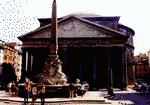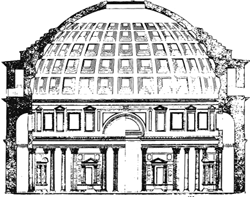pantheon
Pantheon
Pantheon

pantheon

Pantheon
a burial vault of prominent persons. Normally such pantheons are housed in buildings that have, or initially had, religious importance. Examples include Westminster Abbey in London (1245–1745) or the church of Ste. Geneviève in Paris (1764–90; J.-G. Soufflot, architect), which became the French Pantheon in 1791, during the French Revolution.
Pantheon
a temple in Rome dedicated to all the gods and an outstanding example of ancient Roman architecture. It was erected circa A.D. 125 on the site of a temple of the same name constructed by Agrippa. The Pantheon is a rotunda covered by an enormous, coffered dome, with a diameter of more than 43 m. A round opening approximately 9 m in diameter in the center of the dome serves as the source of light for the interior. The dome is made from concrete interlaid with brick. The wall supporting the dome is divided into two tiers on the inside, the lower of which is broken up into seven niches.
There is a harmonious balance in the interior between the height and diameter of the structure. The dome, which dominates the space of the rotunda, is divided into caissons and, not overwhelming the viewer with its weight, majestically towers above him like a firmament. The entrance is accentuated by a portico of 16 Corinthian columns, with eight in the front and eight in the back. Remarkable for its breathtaking grandeur and unity of form, the Pantheon exerted a great influence on the architecture of its time and of succeeding eras. In the Middle Ages, when it was subjected to frequent partial alterations, the Pantheon was converted into a church. Today it is a national mausoleum where prominent figures in Italian art, including Raphael and B. Peruzzi, are buried.